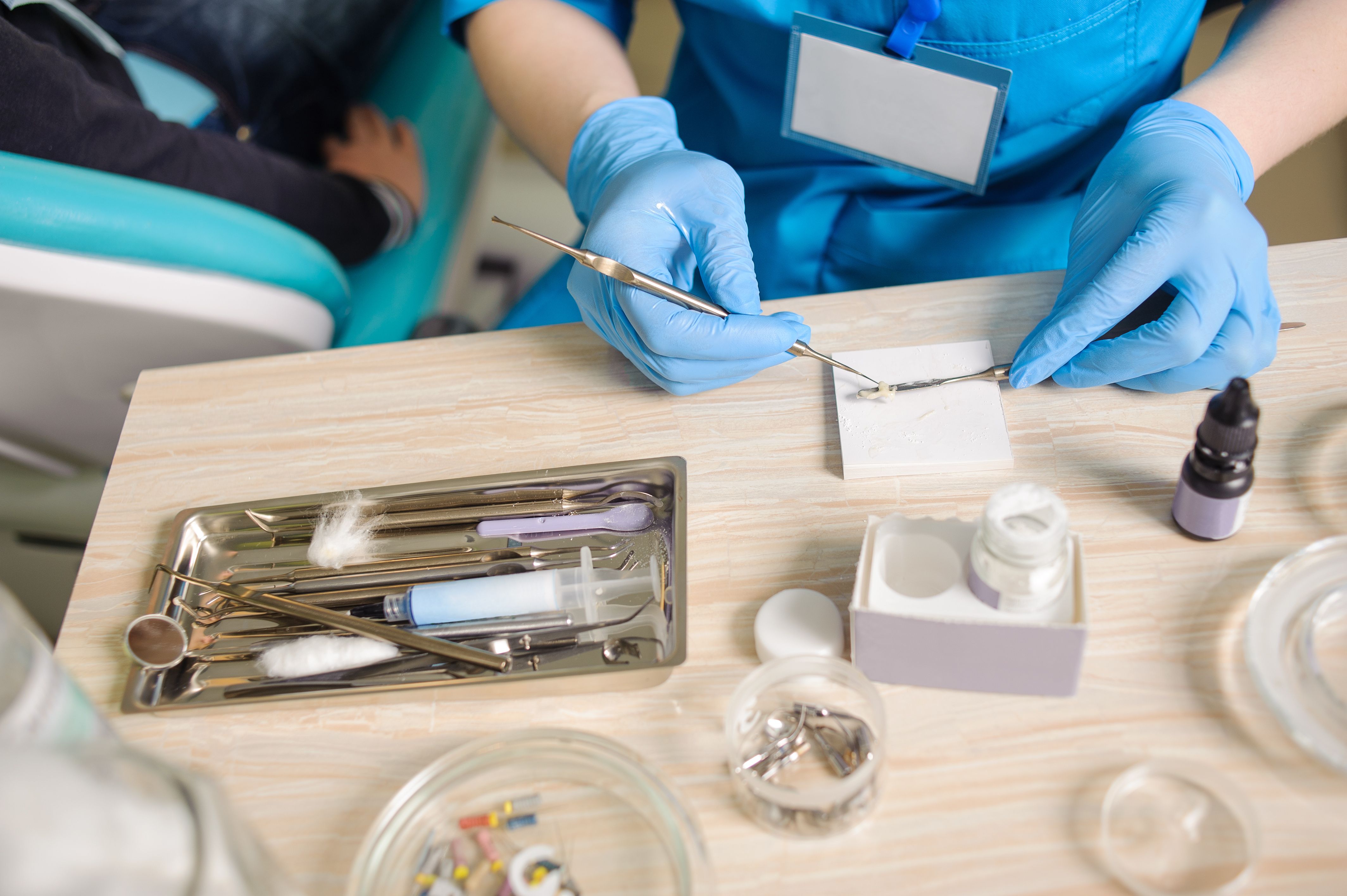The Who, What, When, Where, Why, and How of Glass Ionomers
60 years on, the material continues to be a workhorse in a dentist’s armamentarium.


The 1960s were a busy time in materials science. After serving in the United States Army and graduating from USC’s Dental school in 1953, Dr Rafael Bowen joined the American Dental Association’s Research Labs in 1956.1 In the early 1960s, Dr Bowen discovered how to chemically treat particles to bond with polymer-containing substances to create a robust restorative material.2 That restorative material is bisphenol A-glycidyl methacrylate (Bis-GMA), and it transformed the practice of dentistry. This composite resin has been used in restorative materials for more than 50 years.1
What are glass ionomers?
In the late 1960s, a second material—known for its high fluoride release and low solubility—emerged that facilitated minimally invasive preps and improved the restorative seal while reducing microleakage.3 It was a glass ionomer. Now, 60 years later, the material continues to be a workhorse in a dentist’s armamentarium.
Glass ionomer, however, is a misnomer. According to the International Organization for Standardization, the official term for them is “glass polyalkenoate cement,” but no one calls them that. Glass ionomer is the recognized term widely used by dental professionals.4
Glass ionomers have three types:4
- Glass ionomers: Glass ionomer cements are polymeric acid, glass, and water. The polymeric acid is either the homopolymer or copolymer of acrylic acid. The glass particles are basic glasses, meaning they react with the acid to form a salt. The glasses used are alumino-silicate glasses with fluoride and phosphate added to them. They are self-setting, using an acid-base reaction.
- Resin-modified glass ionomers: Introduced in 1991, resin-modified glass ionomers have the same components, plus a monomer component (usually 2-hydroxyethyl methacrylate) and an initiator (camphoquinone). The “resin” means these materials are set based on an acid-base reaction and polymerization.
- Glass carbomer: Designed to have additional bioactivity (more on that later), glass carbomer is a type of glass ionomer. The difference is that there are other materials present, including a bioactive component that behaves as a secondary filler. To set, it has 2 modified acid-base reactions, one with the acid and the glass filler and another with the hydroxyapatite filler. A curing light is used with this material, but not for polymerization. Instead, the curing light increases the temperature of the material to speed up the set time.
How do glass ionomers work?
Glass ionomers are known for their versatility in the operatory. There are quite a few things they do for restorative work:4,5
- They are biocompatible and release biologically beneficial ions into the surrounding fluid, which can reduce the pH of the patient’s mouth and promote remineralization of the tooth.
- They can release fluoride, which can help prevent future caries and inhibit the demineralization of teeth.
- They adhere to the tooth’s surface chemically and through micromechanical interlocking rather than an adhesive system.
- They match the natural tissue for the coefficient of thermal expansion.
Glass ionomer cements are also known for what they don’t do:
- They don’t have a problem with polymerization shrinkage.
- They don’t have a problem with areas challenging to isolate from fluids.
- They don’t cause as much postoperative sensitivity as their composite resin counterparts.
When and where to choose glass ionomers?
There are many clinical situations where glass ionomers, resin-modified glass ionomers, or glass carbomers might benefit the restorations. For example, a 2002 position paper on glass ionomer cement in Pediatric Dentistry stated that the literature supports the following uses for the materials:6
- Luting cement: Whether for stainless steel crowns, orthodontic bands, or orthodontic brackets (although limited on this one), the enhanced physical properties and easy handling make glass ionomer cements a good choice.
- Cavity bases or liners: The best formulations are highly flowable, low-viscosity versions of the materials to get into the areas that need additional protection, sealing, or retention properties.
- Class I, II, III, and V restorations in primary teeth: Depending on the prep, these materials are ideal choices for these restorations for children for their hydrophobic and self-cure properties.
- Class III and V restorations in permanent teeth: Especially for high-risk patients or patients’ teeth that cannot be isolated enough for other materials, these can be great restorative material choices.
- Caries control: When you have high-risk patients, repairs of restorations, and atraumatic restorative treatments, these materials’ properties can help prevent future decay.
However, glass ionomers, resin-modified glass ionomers, and glass carbomers are not only for primary dentition. In his “20 Tips for Using Glass Ionomers” for the American Academy of Cosmetic Dentistry, Daniel Ward, DDS, explains that there are some uses for permanent dentition and grown-ups:7
- Long-term interim restorations: For patients who need to delay a crown, use a glass ionomer in bulk to maintain tooth structure for future crown prep.
- Short-term temporaries: Resin-modified glass ionomers can serve as a provisional protecting the cusps until you can place a crown.
- Restoring cervical lesions for patients on multiple medications: Placing glass ionomers can reduce recurrent decay for patients experiencing xerostomia.
- Buildup underneath crowns: A self-curing glass ionomer can have multiple benefits for small- to medium-sized buildups, such as reducing postoperative sensitivity, protecting against recurrent decay, and providing a stable bond and long-term retention.
- Repairing faulty crown margins: This method can help older patients who have decay around a crown but cannot sit through long treatments.
- Reducing postoperative sensitivity: Using resin-modified glass ionomers under a deep composite restoration can help relieve pain and sensitivity and provide fluoride to protect against decay due to marginal leakage.
- Improving the appearance of class V restorations: Resin-modified glass ionomers have better aesthetics than self-curing glass ionomers and have better retention rates than composites that require dentin bonding systems.
- Improving physical properties in contaminated preps: When you cannot keep it dry for a minute or more, resin-modified glass ionomers will not affect the dentinal bond or the material’s physical properties once it is cured.
Why glass ionomers?
Using glass ionomers or resin-modified glass ionomers and glass carbomers has a lot of benefits. Perhaps one of the manufacturers of the bioactive glass powders says it best, that unlike some other materials used in restorative dentistry, glass ionomers become stronger over time as they absorb water and are less likely to fail. However, from a practical perspective, perhaps the most significant reason to use glass ionomers is the chemical bond they make with the tooth, requiring no bonding agent.8
The researchers in The Journal of Functional Biomaterials have a different take. The bioactivity of glass ionomers creates an interfacial ion-exchange layer with the patient’s tooth, contributing to the durable bond. Glass ionomers also release fluoride for a long time, which isn’t proven to help, but certainly can’t hurt.4
Dr Berg writes that glass ionomers are an excellent material for use in dental operatories, especially when working with children. He notes that their superb handling, ease of use, self-adhesive properties, fluoride-releasing properties, and love of water make them a mainstay in restorative dentistry.6
Like Dr Berg, Dr Ward agrees that glass ionomers are easy to place and are not as technique sensitive as other restorative materials. While they will never replace composite resin materials, Dr Ward writes that they are a helpful adjunct, and that time and experience will show clinicians how they can be the most beneficial in their hands.7
So, the question is not, “Why glass ionomers?” but instead, “Why not?"
References
- Dr. Rafael Bowen obituary. The Washington Post. April 20, 2020. Accessed March 8, 2022. https://www.legacy.com/us/obituaries/washingtonpost/name/rafael-bowen-obituary?id=2021842#:~:text=Bowen%20developed%20Bis%2DGMA%2C%20which,of%20the%20Paffenbarger%20Research%20Institute.
- Bayne, SC. Beginnings of the dental composite revolution. J Am Dent Assoc. 2013;144(8):880-884. doi:10.14219/jada.archive.2013.0205
- Wilson, AD. Glass-ionomer cement--origins, development and future. Clin Mater. 1991;7(4):275-282. doi:10.1016/0267-6605(91)90070-v
- Sidhu SK, Nicholson JW. A review of glass-ionomer cements for clinical dentistry. J Funct Biomater. 2016;7(3):16. doi:10.3390/jfb7030016
- Nicholson JW, Sidhu SK, Czarnecka B. Enhancing the mechanical properties of glass-ionomer dental cements: a review. Materials (Basel). 2020;13(11):2510. doi:10.3390/ma13112510
- Berg, JH. Glass ionomer cements. American Association of Pediatric Dentistry. 2002. Accessed March 1, 2022.
https://www.aapd.org/globalassets/media/publications/archives/berg5-02.pdf - Ward, D. 20 Tips for using glass ionomers: How to use dentistry’s other tooth-colored materials. American Academy of Cosmetic Dentistry. 2011. Accessed March 1, 2022. https://aacd.com/proxy.php?filename=files/Students%20and%20Faculty/20%20tips%20Glass%20Ionomers.pdf
- The advantages of using glass ionomers in dentistry. News Medical Life Sciences. July 10, 2018. Accessed March 1, 2022. https://www.news-medical.net/whitepaper/20180710/The-Advantages-of-Using-Glass-Ionomers-in-Dentistry.aspx